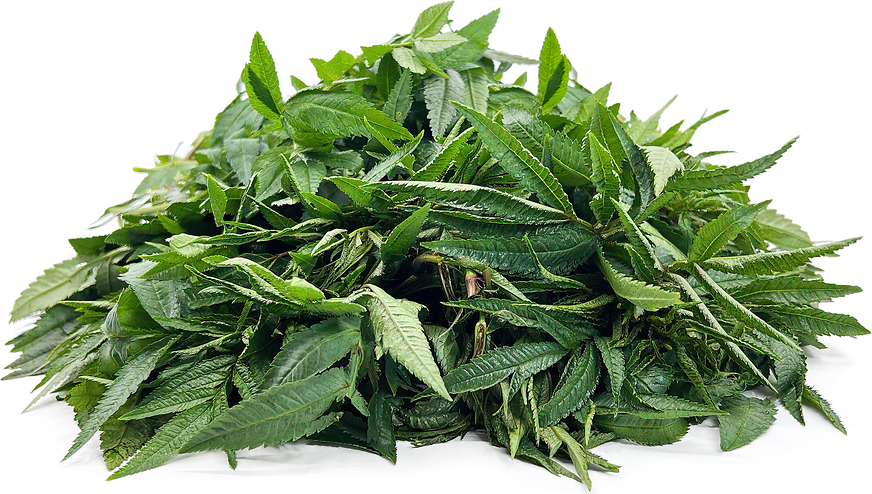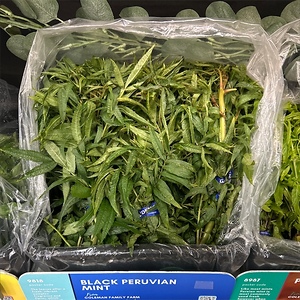


Huacatay
Estimated Inventory, lb : 0
Description/Taste
Huacatay is a branching plant comprised of upright stems and elongated, tapered leaves. The leaves average 8 to 15 centimeters in length and 1 to 2 centimeters in diameter and taper to a point on the non-stem end. The dark green, glossy, and pliable leaves also showcase finely toothed edges, and the leaf’s surface is lightly textured with creases and prominent veining. One distinct feature is the multicellular glands on the leaf’s underside that release aromatic essential oils. These glands sometimes appear orange in color and can also be found on the stems. Huacatay has a crisp, lightly chewy, and succulent consistency and emits a bright, citrusy, vegetal, and herbaceous scent. The leaves can be consumed raw and have a distinct, robust flavor. The taste is said to be a mix of herbal, green, sweet, cooling, and vegetal notes with tarragon, basil, spearmint, and lemon.
Seasons/Availability
Huacatay is available year-round.
Current Facts
Huacatay, botanically classified as Tagetes minuta, is an herbaceous, fast-growing annual plant belonging to the Asteraceae family. The species reaches 0.5 to 1.2 meters in height and is typically found in the wild in a branching, shrub-like appearance. Huacatay is native to South America, and the name is derived from Quechua, an ancient language spoken throughout the Andes Mountains. Huacatay is thought to be derived from “wakatay,” roughly translating to mean “intense smell,” a name given for the plant’s memorable, herbaceous aroma. The edible leaves are the most used portion of the plant and are harvested by hand to protect against damage and ensure sustainability for regrowth. Huacatay is a foundational flavoring in Peruvian cuisine and has been utilized in civilizations in the Andes Mountains since ancient times. The species is known by various names, including Peruvian Black Mint, Mexican Marigold, Menta Negra, Mint Marigold, Aymara Wacataya, Chinchilla, Yerba Luisa, Peruvian Tarragon, and Yerba Buena. The leaves are used in culinary and medicinal preparations and are primarily incorporated fresh, dried, or in pastes. Huacatay is treasured for its intense aroma and flavor in culinary preparations. The leaves have remained a staple ingredient in traditional recipes of South America and have evolved over time as a unique herb to add complexity and bright flavors to modern preparations.
Nutritional Value
Huacatay is a source of vitamin C to strengthen the immune system, calcium to build strong bones and teeth, phosphorus to repair tissues, and iron to develop the protein hemoglobin for oxygen transport through the bloodstream. The leaves also provide potassium to balance fluid levels within the body, antioxidants to protect the cells against the damage caused by free radicals, and antiviral, antibacterial, anti-inflammatory, and antispasmodic properties. In South America, Huacatay has been used as a natural remedy throughout communities in the Andes Mountains. The leaves are sourced as a natural insect repellent and are left around households to release their pungent aroma. Essential oils are also extracted from the leaves and are utilized in preparations to soothe symptoms of colds, asthma, and inflammation. In Peru, Huacatay leaves are customarily boiled, and the liquid is drunk to settle upset digestive tracts. Some communities use the leaves in recipes to disinfect wounds.
Applications
Huacatay has an aromatic, robust flavor and aroma suited for raw and cooked preparations. The leaves are removed from the stems and are used fresh, dried, or in paste form. It is important to note that Huacatay has a strong taste, and the leaves should be incorporated into recipes a little at a time to prevent the herbaceous nature from overpowering the dish. Huacatay is a traditional South American herb valued for its ability to add flavor, aroma, and coloring to culinary preparations. Fresh leaves can be finely chopped and tossed into salads, stirred into salsas, or blended into sauces and marinades. In Peru, Huacatay is utilized in salsa Huacatay, a sauce typically served with cuy, a dish of fried, flattened guinea pig. Cuy is a delicacy throughout the Andes, and Haucatay contributes refreshing, bright, and herbal notes. Huacatay can also be made into pastes and incorporated into ceviche, various fish dishes, arroz con pollo, causa rellena, and stuffed rocoto peppers. The leaves are notably used in lomo saltado, a Peruvian-Chinese fusion dish, and aji de gallina, a creamy, stew-like meal considered a comfort food in Lima. Huacatay also flavors the sauce in papa a la huancaina, a boiled potato dish, and pachamanca, a method of roasting meats and vegetables in underground ovens. Beyond meat and potato dishes, Huacatay is a foundational flavoring in various soups and stews, mainly locro and cau cau. The herb has also evolved with culinary practices and expanded beyond South American cuisine to be featured in modern dishes such as steak and eggs, chicken, rice dishes, dips, and spreads. While less common than savory dishes, Huacatay is also infused into desserts, including ice cream and mousse. Fresh leaves also blend into cocktails, other beverages, tea, and fruit juices. In Peru, Huacatay is popularly mixed with camu camu as a refreshing drink on warm days. Huacatay pairs well with walnuts, peanuts, lime juice, aromatics including onion, garlic, and chile peppers including aji amarillo, meats such as poultry, beef, pork, and lamb, seafood including scallops, octopus, shrimp, and fish, potatoes, corn, tomatoes, and fresh soft cheeses. Whole, unwashed Huacatay leaves will keep for one week when stored in the refrigerator in perforated bags. Some consumers wrap the leaves in damp paper towels before placing them in the fridge. Despite the leaves' ability to last for a few days, it is recommended to use them immediately for the best quality and flavor. This prevents the leaves from wilting with age. Huacatay can also be dried, frozen, or made into a paste for extended use.
Ethnic/Cultural Info
Huacatay is famously used in traditional and contemporary interpretations of the culinary dish ocopa, also known as ocopa a la Arequipeña. The name ocopa is thought to be derived from the Quechua word oq’pa and has a history connected to the Incas. Legend has it that Incan messengers, known as Chasquis, would carry a bag called oq’pa on long journeys. The role of these messengers was to send notes and news between Incan territories, and oq’pa bags carried culinary ingredients to provide food along the journeys. Peanuts, chile peppers, and herbs were the customary ingredients stored in the bags, and these flavorings were traditionally ground into a paste, believed to provide energy when eaten. One of the herbs was believed to be Huacatay as it grew wild throughout the Andes Mountains, where the Inca Empire primarily resided. Historically, ocopa was used as a name to reference the flavorful paste. The sauce was used as a condiment and eaten with many different dishes for years. When the Spanish arrived in the 16th century, they introduced new ingredients into Peruvian gastronomy, including milk, cheese, garlic, and onions. These ingredients reshaped the foundations of ocopa and transformed it into the thick sauce prepared in the modern day. Over time, ocopa evolved from a sauce to a name of a popular dish that first arose from Arequipa, a city in Southern Peru. The dish is comprised of the fragrant green sauce coating boiled potatoes, hard-boiled eggs, lettuce, shrimp, and charqui, which is dried beef. Arequipa eventually declared ocopa as one of their traditional dishes, and the recipe spread throughout Peru, acquiring many variations based on preferences.
Geography/History
Huacatay is native to South America and has been growing wild since ancient times. The species is thought to have a center of origin in regions of the Andes Mountains, spanning across Peru, Argentina, Chile, Paraguay, and Bolivia. Huacatay thrives in temperate grasslands and was historically utilized by civilizations as a medicinal and culinary herb. Over time, Huacatay spread through natural occurrences and human intervention, expanding the species into the jungle and coastal regions of South America. The Spanish introduced the species worldwide sometime after the 16th century, as they carried seeds of the plant to Africa, North America, Australia, Asia, and Europe. Today, Huacatay is still predominately found wild and cultivated in South America's coastal, mountain, and jungle regions. The species is also planted in home gardens in Peru, especially in Puno, Cusco, and Arequipa, and Bolivia. Outside of South America, some regions label Huacatay as a weed due to its fast-growing, hardy nature. Huacatay can be purchased fresh through local markets, and dried and paste forms are sold online.
Recipe Ideas
Recipes that include Huacatay. One
| Serious Eats |
|
Potatoes and Summer Squash with Black Mint Sauce |
| Great British Chefs |
|
Marinated rabbit with huacatay and maní |
| Lins Food |
|
Ceviche with Peruvian Black Mint (Huacatay) |

















